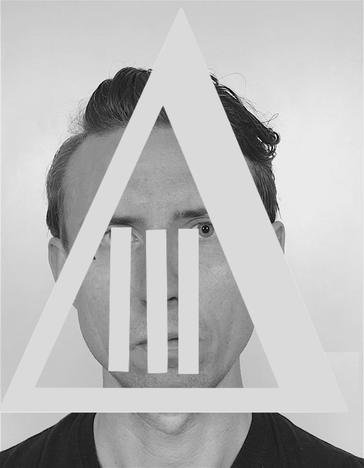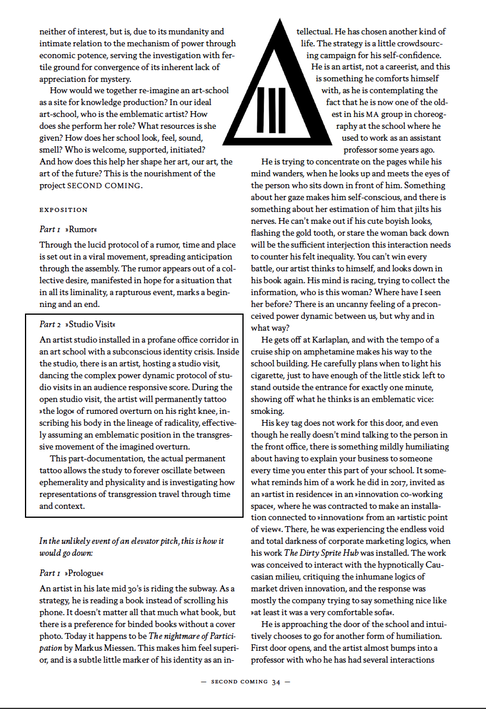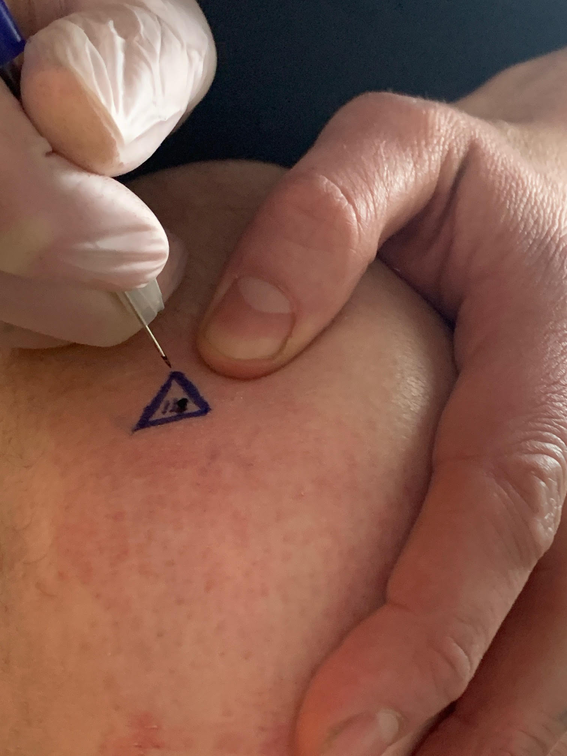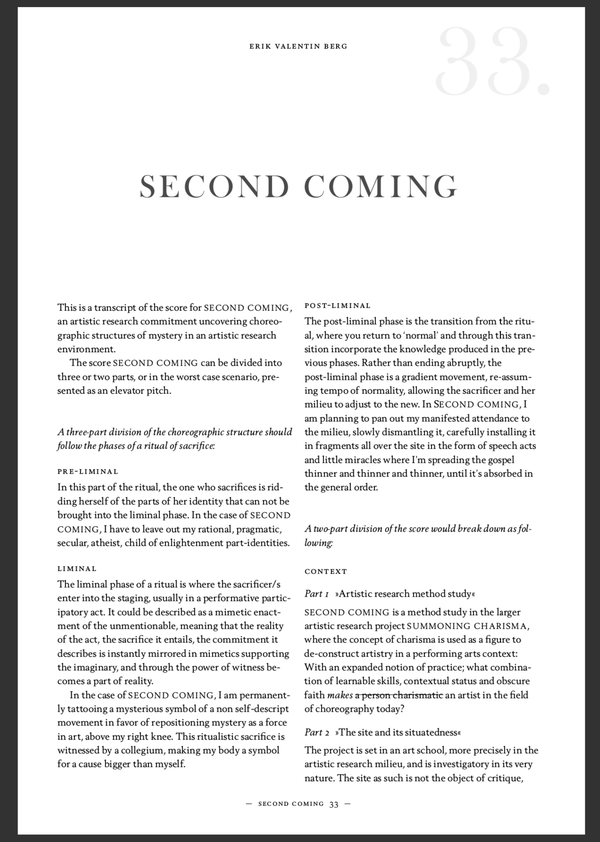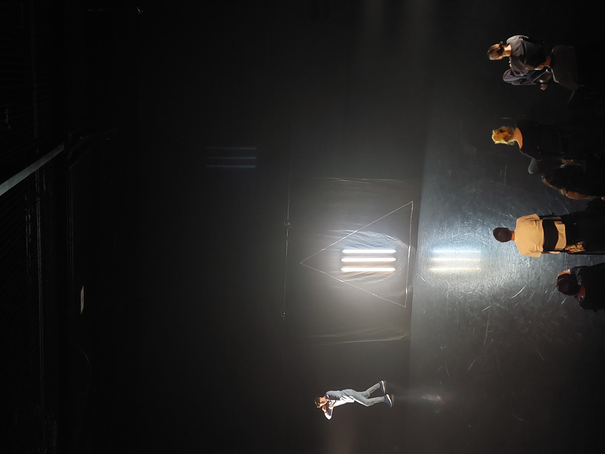SECOND COMING is a dance solo where the inspired body is on critical display. Set in a revival meeting, the audience witnesses the performers' doubts, convictions and speculations. A brief moment of total connectivity changes everything.
To prepare the body to be inspired is a tedious process. It is a slow perforating of your physical and mental integrity, paired with a restless search for a situation where ‘this something’ shall appear and possess you. There is no promises made that you are ever going to be inspired, and the search for inspiration is easily discouraged by everything from your own ethical inhibitions to the overwhelming mundanity of everyday life.
In the age of consent: to imagine that something from outside “you” trangresses your limits, possesses you and animates your interest and practice is a terrifying thought. It was crucial for the research to put my body in its crossfire.
To be inspired may very well be the ability to connect to an inner intimacy, and through that connection activate an animation that incorporates manifest and unconscious currents of creativity. Nontheless, to me it still appears as a mystery. Why am I inspired by Marjoe Gortner?
╫
Bataille, Georges, “The accursed share: an essay on general economy”, New York: Zone Books, 1988
Biesta, Gert, “Letting Art Teach: Art Education 'After' Joseph Beuys”, Arnhem and Amsterdam: ArtEZ Press, 2017
Duve, Thierry de, “Kant after Duchamp”, MIT Press, 1998
Fahlin, Marie “Moving through Choreography – Curating Choreography as an Artistic Practice”, 2021
Houellebecq, Michel “H. P. Lovecraft: Against the World, Against Life”, Gollancz, 1998
Juren, Anne “Studies on Fantasmical Anatomies”, Stockholms konstnärliga högskola, institutionen för dans, 2021
Jönsson, Johan, “ProPonesis : Zoembient Växelvärkansvers: Dikternas”, Albert Bonniers Förlag, 2021
Kuhn, Thomas. S. “The structure of scientific revolutions”, University of Chicago Press: Chicago, 1962
Lacan, Jacques “The Four Fundamental Concepts of Psycho-analysis”, W.W Northon, 1998
Moeller, Hans Georg, d’Ambrosio, Paul J ‘You and your Profile - Identity after Authenticity’, Columbia University Press, 2021
Szyber, Bogdan “Fauxthentication: Art Academia and Authorship (or the site-specifics of the Academic Artist)”, Stockholms konstnärliga högskola, institutionen för scenkonst, 2020
SECOND COMING is a performance in the form of a keynote presentation. Instead of clarifications, there is ambiguity. Instead of criticality there is immersion. Instead of words there is a body moving. For a brief moment, the head of an important congregation appears.
Mystery is a construct manufactured to preserve enigmatic qualities of a thing or a system. It is an onion disguised as orange. Mystery does not produce knowledge - but rather belief. The first attempt in the project SECOND COMING is looking to the significance of belief in research. How hunches, inclinations and ambiguous identification can be constructed and shared in such an environment hostile to its genesis. The research process led me through the discourse of organized faith and its struggle with facts and measurability, trying to locate an index point “just” before the synthesis of an encounter with enlightenment ideals of objectivity.
Thomas Kuhn claims in “The structure of scientific revolutions' ', that a paradigm can only change when the guardians of the hegemonic discourse acknowledges the anomalies in their paradigm, brought forward by the revolutionaries. In the case of SECOND COMING, the claim for the hegemonic discourse is put in movement, and for a brief moment, the room moves with it.
SECOND COMING is a choreographed studio visit where an artist keeps a promise. Set in an art-school office space, the audience witnesses the performer’s conflicted longing for radical artistic lineage.
The documentation of this event will be permanent.
In ‘You and your Profile - Identity after Authenticity’, Hans Georg Moeller and Paul J.d’Ambrosio argue that “the profile” marks an epochal shift in how we perceive ourselves and our identity. Departing from the notion of sincerity - we are what we are told, to authenticity - we are who we (really) are, we have now entered the age of profilicity - we are who we say we are. The research was faced with a dilemma: Who am I?
A promise had been made. The performativity of the statement was not enough. It was disregardable as an act of profile making, a tentative positioning unanchored in time. The maintenance of the mystery demanded a sacrifice. I had to sacrifice who others believed I was, and bring the authentic body into the lineage.
This exposition of SECOND COMING was motivated by a promise in a text, originally written for Prof. Rebecca Hilton’s “Occupy Research Corridor”, later published in Koreografisk Journal #7. The written score and crucial props had been kept in a time capsule planted in the school for a year, and was unpacked for this event.
SECOND COMING is scored artistic research commitment in the form of a text. Set in an issue of a journal focusing on artistic research, the text is uncovering choreographic structures of mystery. The score SECOND COMING can be divided into three or two parts, or in the worst case scenario, presented as an elevator pitch.
In search of convergence in the relationship between meaning and time, the notion of ‘promise’ surfaced in the research. How does a promise really work? It gives a picture of a desired outcome of a process. As a device, it prompts the reading of signs and symbols, turning ambiguity in its favor. If it works, its meaning is a mystery. If it doesn't work, time is a mystery.
A traditional written score seldom works as a promise. Rather it is an instruction that leaves room for interpretation, translation and approximation. How can I bring meaning and time closer together using text? And how much is then left to the reader, to source the mystery through their own reading and imagination?
Through publishing the text, it becomes a part of the choreography of SECOND COMING. It is a transcript of process, time, outcomes, belief, convergence and faith. It incorporates elements from autofiction, project description and rituals. When it works, it is (still) a mystery.
The artistic research commitment SECOND COMING focuses on the role of mystery in choreographic practices, dancing and writing.
The commitment, stemming from the need to partially understand the process of becoming in relation to my formation as a choreographer, departs from the question:
What combination of learnable skills, collegial support and obscure faith does an artist need in the age of uncertainty?
The two year process has emitted four expositions each with a particular take on the material. The research has been informed by the search for meaning in a triangular symbol that appeared in a full drop meditation on November 24 2021.
╫
Margrét Sara Guðjónsdóttir - FULL DROP into the BODY.
The meditative deep tissue release FULL DROP into the Body practice was developed whilst creating a body of artistic works that focus on exploring pathologies of the social-political body within our own bodies and how that reality expresses itself.
The practice brings together the physiological and psychological states of the body, exploring subconscious and energetic realities of embodied life. The research into this type of embodiment catapulted a process of mapping out a new category of performative body language, ways of developing it and transferring the knowledge both practically and theoretically to the wider international dance scene and academia.
https://msgudjonsdottir.com/index.php/research-vision/ retrieved 20220205
“Glorified Idiot” presented amongst other places in Jassem Hindi’s workshop “The concept and the idiot” Impulztanz, Vienna 2013, vaguely elaborated and noticed in the workshop description: https://www.impulstanz.com/en/archive/2013/workshops/id2222/
retrieved 2021-10-12
Concept, choreography, performance: Erik Valentin Berg, Music: Mats Erlandsson, Supervision: Margret Sara Gudjónsdóttir, Andrious Mulokas
Published in Koreografisk Journal #7 "Koreografi och Konstnärlig forskning", Red. Rebecca Chentinell & Marie Fahlin. Photo: Ofelia Jarl Ortega
Concept, choreography, performance: Erik Valentin Berg, Music: Mats Erlandsson, Camera: Nasreen Aljanabi Larsson
╫
Mats Erlandsson, “Slakt”, 2020 “Minnesmärke” 2020 From “Minnesmärke” 2020, “Cellar”, 2019, from “4-Track Guitar Music “ 2021
SUNN o))) “Ascension (A)”, “Frost (C)”, “Kingdoms (D)” from “Pyroclasts”, 2019
Elaine Radigue "Kyema" (Intermediate states), “Koume”, From “Triologie de la Morte” , 1994
Black Sabbath “Children of the Grave” from “Master of Reality”, 1971
╫
“Marjoe” 1972, Dir. Howard Smith, Sarah Kernochan
“Buffalo 66’” 1998, Dir. Vincent Gallo
"Dogtooth" 2009 Dir. Yorgos Lahtimos
Concept, Choreography, Performance: Erik Valentin Berg, Assistance: Stella Kruusamägi, Music: Mats Erlandsson, Camera: Ofelia Jarl Ortega
Suspisions has been voiced through out the process, that SECOND COMING, more than an artistic inquiery is fuled by an escapist desire to control the narrative around the author.
This text aims to direct a critical gaze to the position of the author/subject/artist, and relentlessly engage with the mundanity of everyday life.
And the artist entered the supermarket Coop with a strange delirious tiredness he recognized from his studies in contemporary aesthetics and art history at Södertörn University college between the years 2004-2007. He was trying to stay focused shopping for tonight's dinner, returning to the plate model, trying to compose a meal from its rigid form with measures of carbs, protein and fibers. Under severe pressure to eat more healthy and plant-based food, he kept struggling with the protein sources, trying to strike a balance between something he would like to cook and the kid would like to eat. Recalling a conversation with Nefeli about distinguishing denominations of material, method and form, trying to apply the reasoning to the project at hand; dinner. He found himself looking at the more luxurious ready-to-eat meals where his gaze landed on spinach soup. Gut feeling. Almost like a tongue licking your intestines guided by a soothing french accented voice.
The artist turned 180 degrees walking against the stream of people making their way through the supermarket to pick up yellow onions and then turn back, heading for the dairy department to pick up cream. His mind was all made up. Spinach soup it is. Was this a sign of iron-deficiency? What if he would bake the bread himself? The check-out line was just long enough to text his ex wife, asking for her special recipe of the soup, as he knew how much she loved the feeling of being the-one-who-saves-the-day, and her passionate relationship to well cooked food with a certain “agriculture contract worker” feel to it. He put his phone back into the pocket of his bulky but elegant black winter coat, just in time to fire a smile at the cashier to observe if his en-passant flashing of his gold-tooth in the upper front row would produce a little reaction, some kind of interest in his past and present identity through the dreamy vehicle of sexual mystique. The strict but quirky looking cashier looked back at him, a little longer than customary, and responded with a crooked smile, proceeding to check his products, alternately letting her eye-liner painted eyes follow the flow of products on the travelator and occasionally looking up at the artist.
The payment procedure was always scarce, a moment of suspended anticipation of impending doom caused by the many times his payment card rendered the mean red cross of the terminal, beeping loudly signaling the letters “ D E C L I N E D”. Like so many times before, the same recalls flashing through his head; how many drinks last weekend, how long since paying bills, what date is today, could the invoice sent to the teaching gig have cleared, as the two seconds of intense staring at the terminal finally came to an end. The artist, filled with relief from the absence of humiliation fires another one of his “unconscious” subtle tricks: instinctively saying no to the offer of a printed receipt, but changing his mind about it really quick, as it meant yet another contact point when the cashier leaned back against him to hand him the receipt. The trick did not produce the kind of smile he hoped for, but a more disappointing and detached one.
He kept going through today's research seminar over and over in his head. He understood the artistic researcher’s project, both the topic and the rationale of it. But had missed his opportunity to prove himself critical. To critically ask about the existing knowledge and research within the field? How he could have punctuated his superior conversation partner in a well informed, not obviously polemic way. How could he also, without taking the air out of the conversation, maybe more clearly stated his familiarity with artistic research as such? Having spent almost an entire year working with Bogdan Szyber’s “Fauxtenthication” project, researching the whole artistic research field in sweden, ending up performing the role of curator for an historical exposé of swedish artistic research, all possible guilds represented in a staged museum exhibition held open to the public in the Swedish museum of History’s baroque sal in october 2018. If he had only somehow found a possible entry somewhere in the tight weave knit of his counterpart's self-justification speech about the possibilities of artistic knowledge production.
Grunting, he picked up his DOCH - University of Dance and Circus tote bag, and left through the doors at a firm pace, ready to go locate different coating trousers and sandy socks. The final thirty meters before the door, he pinned his gaze to the ground, and braced himself. He had enough cherie hello’s and smalltalk for today, and the mere thought of the mundaneness of the conversations in this space was enough for him to get ready to push the eject button of his fighter aircraft. He mentalized shooting himself out in thin air over europe. Something arose in him, filling him up in a way that I imagine Isaac Newton might have felt, realizing that he (as he thought) was the second coming of Jesus Christ, thinking: “maybe this could be a way of proposing my contribution to the knowledge production of performative and mediated practices? What if I, through an artistic project relevant to my practice, studied and documented its methods? What if I just made such a postulate, that my legitimacy as an artist, choreographer, stemmed from that method, rather than a form-oriented craftsmanship talent? There should be something about an interface in the paradigm of expanded practice.
The artist was just about to lit fire to a cigarette two meters outside the door of a Stockholm montessori school, absorbed by his fantasy, somatically experiencing the touch of falling through thin air at the speed of 120 mph (200 kph), and with a reflex resembling pulling a parachute, he put his lighter back into his right front pocket of his skinny black jeans, looking down on his vegan edition Dr. Martens shoes. He realized, he had had an unfair assessment of the possibilities of artistic research, that his very generalized critique of the field as vague, too academic, and at a safe distance to the real world of art production was merely a question of framing. That his preconceived notion of artistic research as “not for him” stemmed from his complex relationship to the term practice based, as he had trouble fitting his image of his practice into the discourse of artistic research. That it was a question of seizing the opportunity to take part in the development of the discourse, through putting his practice as a research object through a project serving as a vehicle for a discussion of what constitutes artistry in post-conceptual choreography. Maybe, the artist mumbled to himself. If there is the possibility to teach in conjunction with the research, wouldn't that be something. He recalled what Joseph Beuys had said, when he, as his last act as vice chancellor of prestigious art school städelschule in Frankfurt, dismantled the whole admission system and decided to grant everyone who applied to the school:
“You don’t know who is going to become an artist”
